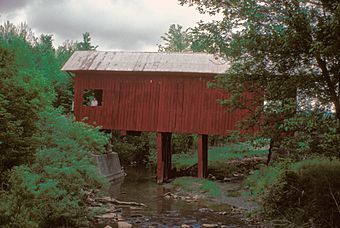Erskine Covered Bridge facts for kids
Quick facts for kids |
|
|
Erskine Covered Bridge
|
|
 |
|
| Nearest city | West Alexander, Pennsylvania |
|---|---|
| Area | 0.1 acres (0.040 ha) |
| Built | 1845 |
| Architect | Gordon, William |
| Architectural style | Queenpost truss |
| MPS | Covered Bridges of Washington and Greene Counties TR |
| NRHP reference No. | 79002359 |
| Added to NRHP | June 22, 1979 |
The Erskine Covered Bridge is a really old and special bridge in West Alexander, Pennsylvania. It's called a "covered bridge" because it has a roof and sides, just like a house!
This bridge is super important because it's been named a historic landmark. The Washington County History & Landmarks Foundation officially recognized it as a piece of history worth protecting.
What Makes Covered Bridges Special?
Covered bridges are like time capsules from the past. They were built a long time ago to help people cross rivers and streams safely. The roof and sides weren't just for looks. They actually protected the wooden parts of the bridge from rain, snow, and sun. This helped the bridge last much longer!
Building the Erskine Bridge
The Erskine Covered Bridge was built way back in 1845. Imagine, that's almost 180 years ago! A person named William Gordon was the architect, which means he designed how the bridge would look and be built.
The bridge uses a special design called a Queenpost truss. This is a type of strong wooden framework that helps the bridge hold up its own weight and the weight of people and wagons crossing it. It's like a clever puzzle of wooden beams that makes the bridge super sturdy.
Protecting This Historic Landmark
Because the Erskine Covered Bridge is so old and important, it was added to the National Register of Historic Places on June 22, 1979. This is a list of places across the United States that are considered historically significant. Being on this list helps make sure the bridge is preserved for future generations to enjoy.
The bridge is managed locally, meaning people in the area help take care of it. It's a great example of how communities work to keep their history alive.
Template:Washington County History and Landmarks Foundation



